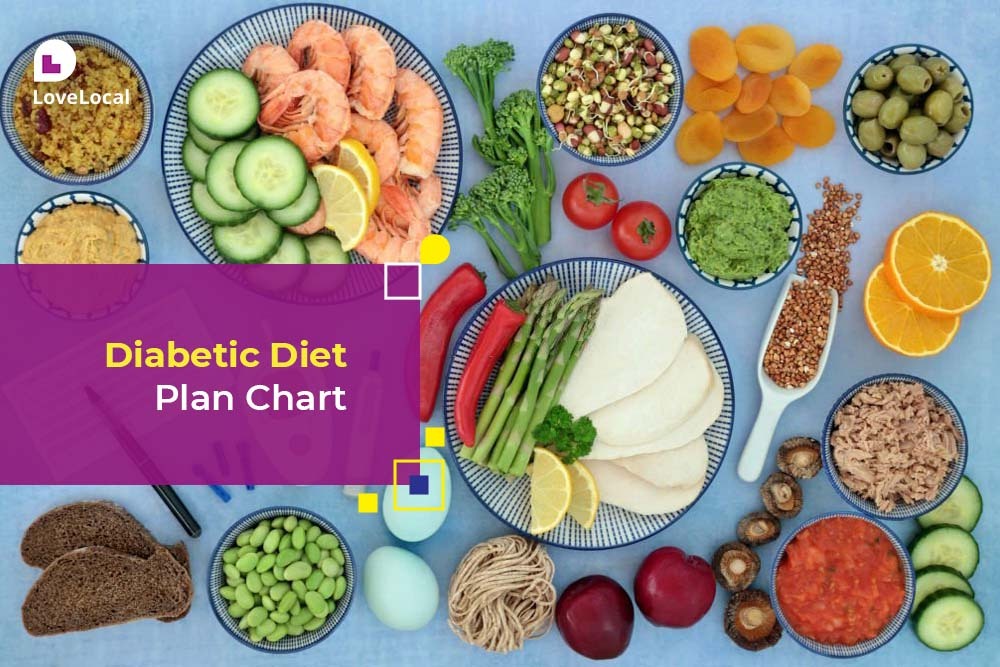Diabetes is a chronic disease that affects millions of people worldwide. It occurs when the body is unable to regulate blood sugar levels properly. The primary cause of diabetes is a lack of insulin, a hormone that helps the body use glucose (sugar) for energy. While diabetes cannot be cured, it can be effectively managed through medication, a healthy lifestyle plan, and a healthy diet. In this blog, we will discuss the diabetic diet plan and how it can help you manage your diabetes.
The goal of a diabetic diet plan is to maintain stable blood sugar levels throughout the day. This is achieved by consuming a balanced diet that consists of carbohydrates, proteins, and fats in the right proportions. The American Diabetes Association recommends that diabetic individuals consume a diet that consists of 45-60% carbohydrates, 15-20% protein, and 25-35% fat.
- Carbohydrates are an essential part of the diabetic diet plan as they provide the body with energy. However, it is crucial to consume carbohydrates that have a low glycemic index (GI). Foods with a low GI release sugar slowly into the bloodstream, preventing spikes in blood sugar levels. Examples of low GI carbohydrates include whole grains, legumes, fruits, and vegetables. High GI carbohydrates, such as white bread, sugary drinks, and processed foods, should be avoided or consumed in moderation in a diabetes diet menu.
- Protein is also an essential part of the diabetic diet plan. It helps repair and build muscle tissue, and it also helps keep you feeling full for longer periods, reducing the urge to snack on unhealthy foods. Good sources of protein, such as lean meats, fish, beans, and low-fat dairy products, are part of the diabetic high protein diet.
- Fats are also an essential part of the diabetic diet plan. However, it is essential to consume healthy fats, such as monounsaturated and polyunsaturated fats, instead of saturated and trans fats during a diabetic weight loss diet. Good sources of healthy fats include olive oil, avocados, nuts, and seeds.
In addition to consuming a balanced diet, which consists of a diabetic diet plan, it is essential to eat at regular intervals throughout the day. Skipping meals or eating irregularly can cause spikes in blood sugar levels, making it harder to manage diabetes. It is recommended that diabetic individuals consume three main meals and two snacks per day.

Fruits to have in a diabetic diet plan:
A diabetic diet plan typically includes a variety of fruits in moderation, as fruits contain natural sugars that can affect blood sugar levels. However, the type and amount of fruit recommended may vary depending on individual factors such as blood sugar control, medications, and overall health.
Here are some fruits that are generally considered good options for people with diabetes:
1. Berries:
Berries are low in sugar and high in fiber, making them a good choice for people with diabetes. Examples include strawberries, blueberries, raspberries, and blackberries.
2. Citrus fruits:
Citrus fruits such as oranges, grapefruits, and lemons are good sources of vitamin C and fiber. However, people on a diabetes diet menu should limit their intake of fruit juices, as these can raise blood sugar levels quickly.
3. Apples:
Apples are high in fiber and antioxidants, which can help lower the risk of heart disease and other health problems. However, people with diabetes should eat apples in moderation, as they contain natural sugars.
4. Cherries:
Cherries are low in calories and carbohydrates and have been shown to have anti-inflammatory properties. However, they should be eaten in moderation, as they do contain natural sugars.
5. Melons:
Melons such as cantaloupe and watermelon are low in calories and high in water content, making them a good choice for diabetes diet menu. However, people with diabetes should monitor their blood sugar levels closely when eating melons, as they can raise blood sugar levels quickly.
It’s important to note that while fruits can be part of a healthy diabetic diet plan, they should not be the only source of carbohydrates. People with diabetes should work with a registered dietitian or healthcare provider to determine their individualized carbohydrate needs and meal plans.

Diabetic diet plan restrictions:
The diabetic diet plan does come with some restrictions to help individuals with diabetes maintain stable blood sugar levels. Some of the dietary restrictions include:
- Limiting simple carbohydrates: Simple carbohydrates, such as refined sugar, white bread, and processed foods, can cause spikes in blood sugar levels. Therefore, it is recommended that, in a diabetic meal plan, they limit their intake of these foods.
- Limiting saturated and trans fats: Saturated and trans fats can increase the risk of heart disease and contribute to insulin resistance, a key feature of type 2 diabetes. Therefore, in a diabetic diet plan, it is essential to limit the intake of foods high in saturated and trans fats, such as red meat, full-fat dairy products, and fried foods.
- Limiting alcohol: Drinking alcohol can cause blood sugar levels to fluctuate, making it harder to manage diabetes. Therefore, it is recommended that individuals with diabetes limit their alcohol intake or avoid it altogether.
- Limiting sodium: Consuming too much sodium can increase blood pressure and increase the risk of heart disease, a common complication of diabetes. Therefore, it is recommended that individuals with diabetes limit their sodium intake by avoiding processed foods, salty snacks, and canned goods.
- Monitoring portion sizes: Overeating can cause blood sugar levels to spike, making it harder to manage diabetes. Therefore, it is recommended that individuals with diabetes monitor their portion sizes and avoid overeating.
By following these restrictions and a proper diabetic meal plan, individuals with diabetes can maintain stable blood sugar levels, reduce the risk of complications, and improve their overall health and well-being. However, it is essential to consult with a registered dietitian or healthcare professional before making any significant changes to your diet.
Here is a sample diabetic diet plan:
- Breakfast: A bowl of oatmeal with low-fat milk, topped with berries and a tablespoon of almond butter, is perfect for a diabetes diet menu.
- Snack: A small apple and a handful of almonds.
- Lunch: A chicken and vegetable stir-fry with brown rice.
- Snack: A cup of Greek yogurt with sliced strawberries.
- Dinner: Grilled fish with roasted vegetables and a small sweet potato is a great part of the diabetic weight loss diet.
In addition to following a healthy diabetic diet plan, it is essential to stay hydrated by drinking plenty of water throughout the day for a healthy lifestyle plan. Drinking sugary drinks such as soda or juice can cause spikes in blood sugar levels, and therefore should be avoided or consumed in moderation.
Exercise is also an essential part of managing diabetes. Regular physical activity can help lower blood sugar levels, reduce the risk of heart disease and stroke, and improve overall health and well-being. The American Diabetes Association recommends at least 150 minutes of moderate-intensity exercise per week. Examples of moderate-intensity exercises include brisk walking, cycling, swimming, and dancing.

Who should follow this diabetic diet plan?
The diabetic diet plan is primarily designed for individuals with diabetes or those at risk of developing diabetes. It can also be beneficial for individuals looking to improve their overall health and well-being, as it promotes a balanced diet that consists of nutrient-dense foods such as whole grains, fruits, vegetables, lean protein, and healthy fats. However, it is essential to consult with a healthcare professional or registered dietitian before starting any new healthy diet plan, especially if you have any underlying medical conditions or dietary restrictions.
Conclusion:
In conclusion, a diabetic diet plan is an essential component of managing diabetes. By consuming a balanced diet that consists of low GI carbohydrates, lean protein, and healthy fats, individuals with diabetes can maintain stable blood sugar levels throughout the day. It is also important to eat at regular intervals, stay hydrated, and exercise regularly to manage diabetes effectively. Consult with a registered dietitian or healthcare provider for a personalized diabetic diet plan that meets your specific needs and goals.



